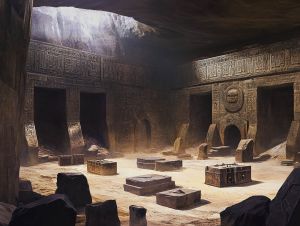Tarsu-un
| Tarsu-un | |
|---|---|
| Image |  |
| City | Kar-Thal |
| Realm | Terasil |
| Function | Quarry Access and Miner Clans |
Introduction
Tarsu-un is the outermost district of Kar-Thal, situated closest to the city’s vast quarry networks. It is the dwelling place of the stonecutters, tunnel shapers, and strata-cleavers whose labor forms the physical and civic foundation of the city. The district is known for its austere tone, unadorned architecture, and the lineage-bound miner clans who operate in multigenerational guilds of the Duranthi tradition.
Function
Tarsu-un serves as the logistical spine for raw material extraction and tunnel expansion. Its corridors lead outward into the functional arms of the Citadel Mountains, providing direct access to basalt flows, mineral deposits, and untouched fault layers. The district houses tool-makers, chisel forgers, quarry scribes, and dust-weighers, all of whom are vital to the rhythm of Duranthi civic continuity.
Beyond its industrial role, Tarsu-un maintains sacred relationships with living stone—rituals of permission and fracture conducted in silent observance before each excavation.
History
Tarsu-un was established during the early expansion of Kar-Thal, when internal space became limited and controlled quarrying became necessary to support the city’s growth. Initially little more than a cluster of open shafts and rough dwellings, the district evolved into a structured guild network over time.
Notable Locations
- Stone-Fall Commons – An open plaza used for load transfer and clan announcements. Dust-clouded but active.
- Clanforge of Olm-Varek – One of the oldest working forges, maintained by a basalt-working lineage.
- Tunnel Mark Exchange – A carved hall where quarry paths are documented through etched strata maps and lineage approvals.
- Hall of Dust-Weighers – The site of mineral evaluation, yield registration, and civic quota marking.
Cultural Practices
Unlike the more ceremonial districts, Tarsu-un operates in the discipline of necessity. Communication is brief and gesture-led, and tools speak through their use. Clan-stones are placed above entrances and coated with fracture-dust to mark lineage and quarry deeds.
Initiates from Tarsu-un undertake the First Fracture Rite, in which they must extract a vein segment using ancestral tools and present it unbroken to the Hall of Dust-Weighers for inscription.
After a tunnel collapse, the district observes the Stone Silence—a full day of muteness and halted work, out of respect for the fallen and unsettled stone. During this time, only memory tablets are used to record thought and duty.